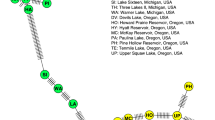Abstract
Genetic analysis of the marine bryozoans Celleporella hyalina and Electra pilosa using the RAPD technique revealed population structuring corresponding to the contrasting modes of larval dispersal. Samples of C. hyalina exhibited genetic differentiation over distances as small as 10 m, concordant with the limited dispersal predicted by a simulation model, based on the short pelagic phase of the lecithotrophic larvae and the local hydrography. In contrast, E. pilosa showed high levels of genetic heterogeneity only over much larger spatial scales, commensurate with its production of comparatively long-lived planktotrophic larvae. The population differentiation observed between samples of E. pilosa, collected from sites 70 km apart, is reconcilable with coastal water currents and frontal systems that restrict the exchange of water masses between the two sites. Hydrographic conditions and discontinuous distribution of suitable substrata therefore are seen to constrain gene flow, creating opportunities for local genetic differentiation despite the high dispersal potential of pelagic larvae.
Similar content being viewed by others
Author information
Authors and Affiliations
Additional information
Received: 9 August 2000 / Accepted: 18 November 2000
Rights and permissions
About this article
Cite this article
Goldson, A., Hughes, R. & Gliddon, C. Population genetic consequences of larval dispersal mode and hydrography: a case study with bryozoans. Marine Biology 138, 1037–1042 (2001). https://doi.org/10.1007/s002270000511
Issue Date:
DOI: https://doi.org/10.1007/s002270000511




